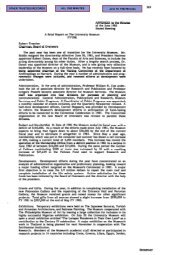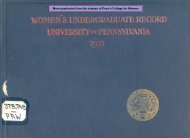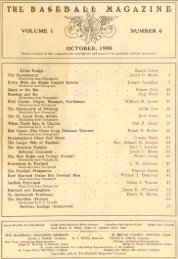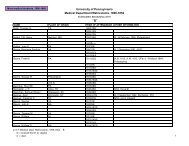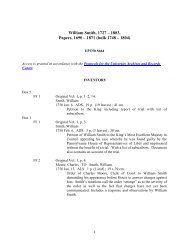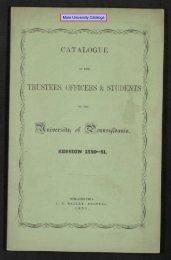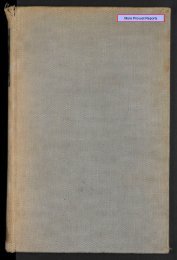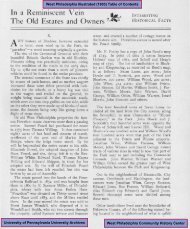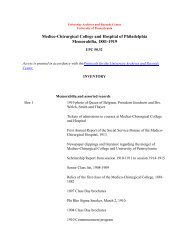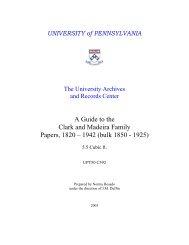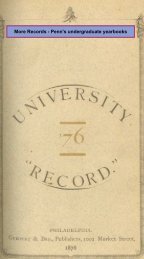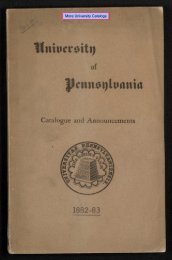Percy C. Madeira - University Archives and Records Center ...
Percy C. Madeira - University Archives and Records Center ...
Percy C. Madeira - University Archives and Records Center ...
You also want an ePaper? Increase the reach of your titles
YUMPU automatically turns print PDFs into web optimized ePapers that Google loves.
And we paid our own expenses .<br />
Competition today is sharply different<br />
from the competition of my day .<br />
The number of contestants in one o f<br />
our national championships of today<br />
would be about equal to the number<br />
of spectators in an average meet of<br />
fifty years ago . The number of athletes<br />
who competed in a fixture like the<br />
Penn Relays last year was greate r<br />
than all the track athletes in the worl d<br />
when I first ran in a race . Th e modern<br />
Olympic Games were years away . The<br />
number <strong>and</strong> quality of competitors t<br />
oday cannot but force each athlete t o<br />
faster <strong>and</strong> faster times by sheer pressure<br />
of numbers, if by nothing else .<br />
And last, but not least, there is the<br />
matter of a competitive mental ceiling .<br />
When a young man of today steps ou t<br />
onto the track to run a quarter mile, he<br />
does so with the knowledge that a<br />
human being has run the distance i n<br />
forty-six <strong>and</strong> a fraction seconds. I n<br />
his mind, consciously or subconsciously .<br />
he tells himself, "If Bill Carr <strong>and</strong> Be n<br />
Eastman can do it . I can do it . "<br />
The dash man of today thinks i n<br />
terms of nine <strong>and</strong> two-fifths <strong>and</strong> nine<br />
<strong>and</strong> five-tenths seconds . The pole vaulter<br />
's goal is fourteen feet, <strong>and</strong> i<br />
limbing toward fifteen feet inch by s c inch .<br />
Even prep-school hurdlers have at mar k<br />
of fourteen <strong>and</strong> a half second s burned<br />
into their brains . They don 't allo w<br />
themselves to aim at anything less .<br />
If, as most coaches will tell you , 90<br />
per cent of being a champion is abov e<br />
the ears, such a mental attitude canno t<br />
help but put wings on a runner's feet .<br />
When I was running . our ideas of<br />
a competitive limit were a four-thirt y<br />
mile, a fifty-second quarter, or a twominute<br />
half. And the men we ra n<br />
against had the same mental ceiling .<br />
I have tried to work out a comparative<br />
chart showing the advantag e in<br />
seconds which the changes that hav e<br />
taken place in the bare mechanics o f<br />
track athletics give the athlete of t<br />
oday over his brother of fifty years ago .<br />
I have had them checked by Lawso n<br />
Robertson, who agrees that I hav e<br />
been fair in my allowances <strong>and</strong> that my<br />
basis of comparative times is sound .<br />
I have not taken into consideratio n<br />
such intangibles as more expert coaching,<br />
more intense competition <strong>and</strong> a<br />
new mental ceiling .<br />
100 yards<br />
220 yards<br />
440 yards<br />
880s yard<br />
1 mil e<br />
TAGE TO ATHLETE OF TODAY<br />
Crouching Start FASTER TRACK TOT<br />
REDUCTION IN CURVES<br />
IN<br />
AL ADVAN<br />
Repeating the old re cords for these<br />
distances <strong>and</strong> deducting the adjustments<br />
referred to, it is found :<br />
100 yards<br />
220 yards<br />
440 yards<br />
440 yards (curves)<br />
880 yards<br />
1 mile (professional )<br />
1 milers (amateur)<br />
THE SATURDAY EVENING POS T<br />
NOT SO FAS T<br />
Continued from Page 1 7<br />
The following table gives th e theoretical performance of 1886 <strong>and</strong> the actua l<br />
performance of 1935 :<br />
220 yards<br />
440 yards straightaway<br />
440 yards around track<br />
s<br />
1 mile<br />
880 yard<br />
No curves, eight-tenths second eliminated<br />
If these adjustments are correct, i t<br />
would appear that the men of fifty<br />
years ago ran nearly as fast as the me n<br />
of 1935. The greatest discrepanc<br />
y appears to be in the half mile, for the me n<br />
of today run this relatively faster tha n<br />
the other distances . Robertson tell s<br />
me it was only about twenty year s ago<br />
that men really learned how to run th e<br />
half mile .<br />
The rules under which the shot an d<br />
hammer were thrown fifty years ago<br />
are entirely different from the rules i n<br />
force today, so that no comparison i s<br />
possible in these events .<br />
The hurdles are now run over individual<br />
barriers <strong>and</strong> in individual lanes .<br />
Each hurdle is built so that it tips over<br />
when it is touched, without necessaril y<br />
breaking a hurdler 's stride . In my day ,<br />
there was one stiff bar all the way acros s<br />
the track. held by rigid supports a t<br />
each end, so that if a hurdler tipped i t<br />
he went down on his face. With no<br />
lanes marked <strong>and</strong> no individual hurdle s<br />
for each man. crowding <strong>and</strong> jostling<br />
was the usual thing . Hurdlers . knowing<br />
the fate in store for them if they hi t<br />
a hurdle, cleared it with plenty t o<br />
spare . They saile d<br />
through the air a t<br />
it, <strong>and</strong> not unti l<br />
the individua l<br />
hurdle came int o<br />
use did Alvi n<br />
Kraenzlein inven t<br />
the step-over technique<br />
whic h made<br />
hurdle jumpin g<br />
nothing more o r<br />
less than an extra long stride with the<br />
hurdle in the middle of it . With the old<br />
sail the hurdler didn't come down ru nning, as he does<br />
today . There was<br />
Distance 1886 RECORDS 1886<br />
Distance 1886 1935<br />
number only about 500 were good<br />
enough to enter a track-championshi p<br />
meet. Today. in Germany alone, there<br />
are upwards of<br />
350,000 men ta king<br />
an active par t<br />
in track <strong>and</strong> fiel d<br />
athletics, <strong>and</strong> i n<br />
America ther e<br />
must be 1,000,000<br />
I suppose tha t<br />
only a few old -<br />
timers like mysel f<br />
have ever heard<br />
of Wendell Baker ,<br />
of Harvard : L . E .<br />
Myers, of the Manhattan Athleti c<br />
Club : W . H . Goodman, of Harvard :<br />
H . S. Brooks, Jr .. of Yale : H . H . Lee ,<br />
of the <strong>University</strong> of Pennsylvania : <strong>and</strong><br />
W . G . George, of Engl<strong>and</strong>. But thei r<br />
names were magic names to conjure<br />
with fifty years ago. Whenever me n<br />
gathered for athletic conversation ,<br />
their feats were hashed over <strong>and</strong> discussed<br />
<strong>and</strong> rnarveled at .<br />
Horace Lee ran the hundred in te n<br />
flat on grass, <strong>and</strong> he had a way of beating<br />
the other ten-second men by a<br />
couple of yards. An old professiona l<br />
runner, Scotty McMasters, told me h e<br />
had frequently timed Lee in bette r<br />
than ten seconds, <strong>and</strong> that with a watc h<br />
that cut a quarter of a second . "Eve n<br />
time " for the hundred was reached a s<br />
early as 1878. The ten-second mar k<br />
acted as a sort of barrier . I t was universally<br />
agreed that no man could ru n<br />
faster than that, <strong>and</strong> many a docker<br />
holding a watch on men lik e Lee <strong>and</strong><br />
Baker <strong>and</strong> Wendell could not believ e<br />
his own eyes when the h<strong>and</strong>s showed a<br />
fraction less than ten flat . <strong>and</strong>, rather<br />
than be laughed to scorn <strong>and</strong> put dow n<br />
as incompetent timers . announced th e<br />
100 yards 10 sec. Held by a number of men .<br />
220 yards 22 sec. Wendell Baker in 1886 .<br />
440 yards straightaway . Wendell Baker in 1886 .<br />
440 yards (two turns) L . E. Myers in 1881 .<br />
12 mile 1 min., sec . L. E. Myers in 1885 .<br />
1 mile (professional) 4 min ., 12 3/4 sec. W. G. George in 1883.<br />
1 mile (amateur) 4 min . . 21 2 5 sec . W . G . George in 1882 .<br />
result as ten seconds flat in loud, dete rmined voices<br />
. I n Engl<strong>and</strong>, any time o f<br />
less than ten <strong>and</strong> one-fifth seconds wa s<br />
viewed with dark suspicion .<br />
The world's records as they existe d<br />
Watches Cutting 1/10 instead of 1/5 second<br />
lines above<br />
d Cambridge<br />
1886<br />
PERFORMANCE<br />
THEORETICAL<br />
ADJUSTMENTS<br />
<strong>Records</strong><br />
n 1880<br />
a distinct pause<br />
after each hurdle<br />
while he gathered<br />
himself for th e<br />
run to the nex t<br />
hurdle .<br />
Track athletics<br />
fifty years ag o<br />
in 1886 are given in the table a fe w<br />
.<br />
Take that mile mark, for example .<br />
Literally . thous<strong>and</strong>s of milers have<br />
made assaults upon it, <strong>and</strong> in fifty-thre e<br />
years we have only been able to lowe r<br />
the record a litt le more than five seconds.<br />
A description of Baker's famou s<br />
were confined t o<br />
a few Easter n<br />
colleges . Ne w<br />
York amateurs, Oxford an<br />
universities in Engl<strong>and</strong> . the Iris h<br />
universities, the harriers <strong>and</strong> the pro-<br />
shoeless quarter-mile race in which h e<br />
established a world's record of forty -<br />
seven <strong>and</strong> three-quarters seconds wa s<br />
printed in The Spirit of the Times . Th e<br />
shoe, by the way, is now in the trophy<br />
case at Harvard . The laces have neve r<br />
fessionals of<br />
Engl<strong>and</strong> . The<br />
just been untied since Baker tied the m<br />
before the race .<br />
total number<br />
of track athletes<br />
in th e<br />
world i<br />
probabl y<br />
would no<br />
t exceed 1500 or<br />
2000. <strong>and</strong> it<br />
is probabl e<br />
The description of the race follows :<br />
THE FASTEST IN THE WORLD<br />
At Beacon Park . Boston . Mass .. July 1 .<br />
The track was laid out on one of th e<br />
straight sides of Beacon Park . which is a<br />
one-mile trotting track, the portion use d<br />
being perfectly level .<br />
440-yard run—W . Baker, 220 yards .<br />
that of tha t 440 yards,<br />
F he won 't clean his pipe <strong>and</strong> giv e<br />
I up that coal-gas tobacco, clip thi s<br />
ad <strong>and</strong> lay it beside his easy chai r<br />
along with a pack of pipe cleaner s<br />
<strong>and</strong> a tin of Sir Walter Raleigh . 'Ti s<br />
thus many a loving wife has freed he r<br />
home from tobacco far too strong <strong>and</strong><br />
odorous for this sensitive world, Si r<br />
Walter Raleigh is a fascinating blen d<br />
of extra-mild <strong>and</strong> extra-fragrant Ken-<br />
tucky Burleys . Smoked regularly i n<br />
a well-kept briar, it makes the ai r<br />
dearer <strong>and</strong> sweeter, <strong>and</strong> sour curtain s<br />
stay fresher . Sir Walter is a sure cure<br />
for nose-bite <strong>and</strong> tongue-bite . And<br />
how men are buying it at onl y 15 cents<br />
a tin! Now it' s your move !<br />
FREE said,<br />
Brown <strong>and</strong> Williamson Tobacco Company Louisville, Kentucky<br />
.<br />
77



